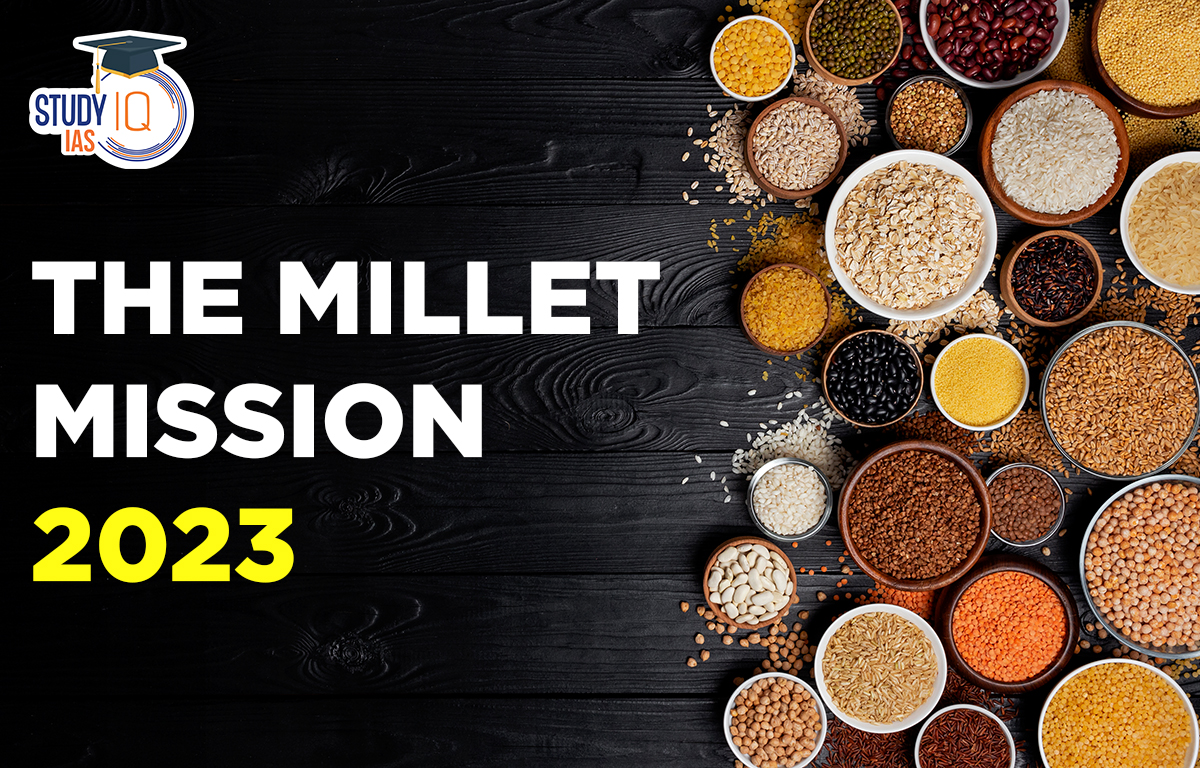Table of Contents
International Year of Millets (IYOM) 2023
- On March 3, 2021, the United Nations General Assembly (UNGA) adopted a resolution to
declare 2023 as the International Year of Millets.- The proposal was moved by India and was supported by 72 countries.
- Significance:
- IYOM will provide an opportunity to increase global production, efficient processing and better use of crop rotation and promote millets as a major component of the food basket.
- Last month, the FAO launched the IYOM in Italy and highlighted that the promotion of millets aligns with Sustainable Development Goals (SDGs) — 1, 3, 8, 12, 13 and 15.
- Political significance for India: Millet is grown mainly in low-income and developing countries in Asia and Africa, and is part of the food basket of about 60 crore people across the globe.
- By proposing the resolution to celebrate 2023 as the International Year of Millets, India pitched itself as a leader of this group.
- This is similar to the Indian initiative on the 121-nation International Solar Alliance.
About Millets
- Millets are part of a group of small-grained cereal crops used as both food and fodder. About 6,000 varieties of these grains with varying colours exist around the world.
- Historical background: They were among the first crops to be domesticated.
- There is even evidence of the consumption of millet in the Indus Valley Civilization.
- Hanging Gardens of Babylon apparently included millet among their treasured plants.
Advantages of Millets


- Global production: Presently, millets are grown in more than 130 countries and consumed as a traditional food by over half a billion people across Asia and Africa.
- Globally, sorghum (jowar) is the biggest millet crop.
- The major producers of jowar are the United States, China, Australia, India, Argentina, Nigeria, and Sudan
India and Millets
- In India, millets are mainly a kharif crop.
- Production: India is the largest producer of millet in the world with a share of 41% in 2020, as per FAO.
- Nine types are grown as kharif crops in over 20 States in the country.
- Rajasthan, Karnataka, Maharashtra and Andhra Pradesh are leading producers.
- For the year 2021-22, about 16 million tonnes millets have been produced in India, which is about 5 percent of the national food grain basket.
- Bajra has the highest market share, followed by jowar.
- MSP for Millets: The government declares a Minimum Support Price (MSP) for jowar, bajra and ragi only.
- Target for procurement: The government has set a target to procure 13.72 LMT coarse grains during the Kharif Marketing Season (KMS) 2022-23, more than double procured during KMS 2021-22.
- Main millet states: Jowar is mainly grown in Maharashtra, Karnataka, Rajasthan, Tamil Nadu,
Andhra Pradesh, Uttar Pradesh, Telangana, and Madhya Pradesh.- Bajra is mainly grown in Rajasthan, Uttar Pradesh, Haryana, Gujarat, Madhya Pradesh, Maharashtra and Karnataka.
- Consumption patterns: In the latest available NSSO household consumption expenditure survey, less than 10 per cent of rural and urban households reported consumption of millets.
- State-wise: Gujarat (jowar and bajra), Karnataka (jowar and ragi), Maharashtra (jowar and bajra), Rajasthan (bajra), and Uttarakhand (ragi).
India’s Efforts to Promote Millets
- Rebranding as ‘Nutri-Cereals’: Millets were earlier referred to as “coarse cereals” or “cereals of the poor”. The Union government renamed these as “nutri-cereals” owing to their high nutritional value.
- National year of millets: The Union government declared 2018 as the ‘national year of millets’ to trigger an increase in demand.
- Initiative for Nutritional Security through Intensive Millets Promotion (INSIMP): A sub-scheme of Rashtriya Krishi Vikas Yojana (RKVY) between 2011 and 2014. The scheme aims to catalyze increased production of millets in the country.
- Millets under PDS:
- Under the National Food Security Act (NFSA), 2013, eligible households are entitled to get rice, wheat, and coarse grain at Rs 3, Rs 2, and Re 1 per kg respectively.
- There is a need to shift the focus of distribution programs from basic calories to provide a more diverse food basket to improve the nutritional status of pre-school children and women of reproductive age.
- NFSM: Under the National Food Security Mission (NFSM), nutritious cereal component for Millets
is being implemented in 212 districts of 14 States. - POSHAN Mission: Millet has also been included under POSHAN Mission campaign.
- Start-Ups: India has more than 500 start-ups in millet value additional food chain. The
government’s Indian Institute of Millets Research has incubated 250 startups.


 Daily Quiz 11 July 2025
Daily Quiz 11 July 2025
 Operation Baam: Baloch Separatist Group ...
Operation Baam: Baloch Separatist Group ...
 Article 326 and Electoral Roll Revision ...
Article 326 and Electoral Roll Revision ...





















